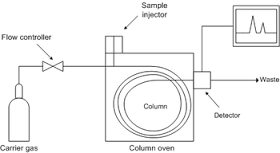DUI blood tests – the gas chromatograph
A gas chromatograph machine is what is used to test for alcohol in DUI cases where there is a blood test taken.
The word “chromatograph” sounds like a mouthful, but it comes from the greek words Chromato, meaning color, and graphy, meaning representation.
Chromatographs are the visual representation of the raw gas chromatograph (GC) data which is in itself inaccessible for use in determining the outcomes of the analyses. The software employed by the analytical equipment takes the raw data and make it possible to visualize the peaks, their area and height and relationship to other peaks in the samples in the form of a chromatogram. X and Y axis give the dimensions for time and response. The Forensic toxicologist is reviewing the chromatograms to report the ID of observed peaks and relative amount of the compounds peaks IDd in each samples chromatogram. The types of chromatograms that are required for every analytical run are as follows: QC, Test mixtures, Method Blanks, Matrix Blanks, absolute/solvent/gas blanks and washes. Not to mention the chromatograms associated with the development of the standard curve and calibrations used in the calculation of the AMOUNT of ethanol over a range ~ca from zero to over 0.5% . Furthermore- you must have the “batch sequence list”- the list of all samples run in that batch showing their sequence, timing and intervals for each type of NAMED injection relative to your clients sample.
QC: quality control: measures the ability of the analytical equipment to do its job to defined qualifications of sensitivity, accuracy and precision. Usually is chromatograms showing the ability of the analytical equipment (GC) to resolve known reference standards of defined amounts of Ethanol over 6 or more injections with +/- a defined value of certainty. Usually a low, 0.8 and high amount of ethanol reference standard is run at the beginning and end of each batch run.
TEST MIXTURES: Chromatography demonstrating the ability of the analytical equipment to baseline resolve each component of a complex mixture of similar compounds to those being tested in suspect samples. Used to demonstrate the ability for complete separation of known compounds, measured against their expected retention time and peak height/area under defined operational parameters. Is the machine is unable to meet the defined resolution, separation and peak heights of a mixture of known compounds, it cannot be used for analysis of unknowns.
METHOD BLANK Chromatogram: When the internal standard “IS” (usually propanol- n- or 2-) is added or “spiked” into a sample and analyzed by GC- used to demonstrate the IS is clean and free of contamination, elutes as a single baseline resolved peaks at its predicted retention time and that it does NOT interfere with the peak of the interest (ethanol).
MATRIX Blanks: using a qualified source of the matrix ( fluid) from which suspect samples are extracted (in this case blood), this known blood matrix is also spiked with the same IS in the SAME concentration to show that the matrix – blood- does NOT affect the peak retention time, peak height or area nor produce any additional peaks in the chromatogram. We mass spectrometrists usually refer to this as checking for “matrix effects”- a very well documented phenomena whereby the same compound in water/solvent behaves differently when in a “Matrix”- thus indicating there are influences of the matrix on the value of that IS in a regular Method Blank to be used as a measurand for accurate reporting of ID or amount of the unknowns.
ABSOLUTE/TRUE BLANK chromatograms: injection of either the carrier gas, methanol or nothing to show that between the sample vial and the detector there is nothing that would contribute to peaks or bumps in a chromatogram that may interfere with the analysis. Demonstrates the analytical equipment is free of any contamination from injector to detector including the column, syringe needle, spepta etc…
Chromatograms of WASHES: performed at intervals within an analytical run as per the defined frequency by that labs accreditation body. Usually it’s every 8-10 injections: used to show lack of contamination and carryover of compounds from one sample to the next when running many suspect samples sequentially in a “batch Run”. A wash is best performed as a methanol or solvent only injection- many labs however include the IS in their “washes” to show the IS peak retention time and height of the IS is consistent throughout the batch run. The inclusion of the IS peaks in this wash chromatogram however can mask or co-elute with any carryover contamination peak(s) and thus is not the best choice as a true wash.
Thus each chromatogram contains the information necessary to determine all the original intent of the analysis: peaks representing each compound found in the samples, the relative amount of each peaks contents, the time at which each peak is present in the timed sample run which can be equilibrated against other peaks to determine identity, and if the analytical equipment is capable of separation of compounds in BOTH a test mixture and of real samples which-biological in origin ( i.e., blood) are the most complicated. Chromatograms are the very essence of what is produced when blood samples are analyzed by GC. If the chromatogram is not present for an analyst to review, there can be no determination of the presence and amount of BA nor the certainty the analytical equipment is capable of such determinations.
For questions, see our Orange County DUI Survival Guide.


